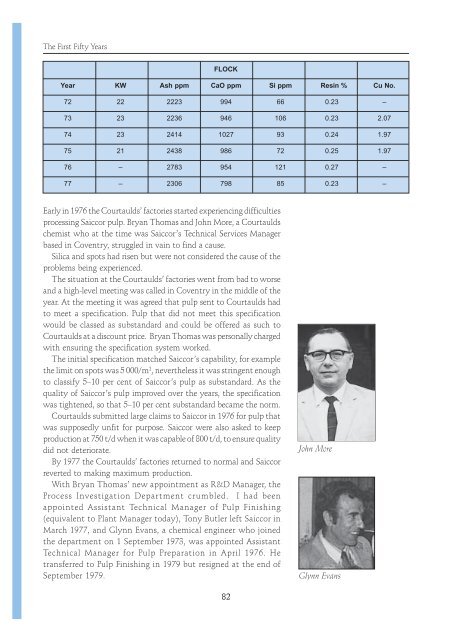Create successful ePaper yourself
Turn your PDF publications into a flip-book with our unique Google optimized e-Paper software.
<strong>The</strong> <strong>First</strong> Fifty <strong>Years</strong><br />
FLOCK<br />
Year KW Ash ppm CaO ppm Si ppm Resin % Cu No.<br />
72 22 2223 994 66 0.23 –<br />
73 23 2236 946 106 0.23 2.07<br />
74 23 2414 1027 93 0.24 1.97<br />
75 21 2438 986 72 0.25 1.97<br />
76 – 2783 954 121 0.27 –<br />
77 – 2306 798 85 0.23 –<br />
Early in 1976 the Courtaulds’ factories started experiencing difficulties<br />
processing <strong>Saiccor</strong> pulp� Bryan Thomas and John More, a Courtaulds<br />
chemist who at the time was <strong>Saiccor</strong>’s Technical Services Manager<br />
based in Coventry, struggled in vain to find a cause�<br />
Silica and spots had risen but were not considered the cause of the<br />
problems being experienced�<br />
<strong>The</strong> situation at the Courtaulds’ factories went from bad to worse<br />
and a high-level meeting was called in Coventry in the middle of the<br />
year� At the meeting it was agreed that pulp sent to Courtaulds had<br />
to meet a specification� Pulp that did not meet this specification<br />
would be classed as substandard and could be offered as such to<br />
Courtaulds at a discount price� Bryan Thomas was personally charged<br />
with ensuring the specification system worked�<br />
<strong>The</strong> initial specification matched <strong>Saiccor</strong>’s capability, for example<br />
the limit on spots was 5 000/m 2 , nevertheless it was stringent enough<br />
to classify 5–10 per cent of <strong>Saiccor</strong>’s pulp as substandard� As the<br />
quality of <strong>Saiccor</strong>’s pulp improved over the years, the specification<br />
was tightened, so that 5–10 per cent substandard became the norm�<br />
Courtaulds submitted large claims to <strong>Saiccor</strong> in 1976 for pulp that<br />
was supposedly unfit for purpose� <strong>Saiccor</strong> were also asked to keep<br />
production at 7<strong>50</strong> t/d when it was capable of 800 t/d, to ensure quality<br />
did not deteriorate�<br />
By 1977 the Courtaulds’ factories returned to normal and <strong>Saiccor</strong><br />
reverted to making maximum production�<br />
With Bryan Thomas’ new appointment as R&D Manager, the<br />
Process Investigation Department crumbled� I had been<br />
appointed Assistant Technical Manager of Pulp Finishing<br />
(equivalent to Plant Manager today), Tony Butler left <strong>Saiccor</strong> in<br />
March 1977, and Glynn Evans, a chemical engineer who joined<br />
the department on 1 September 1973, was appointed Assistant<br />
Technical Manager for Pulp Preparation in April 1976� He<br />
transferred to Pulp Finishing in 1979 but resigned at the end of<br />
September 1979�<br />
82<br />
John More<br />
Glynn Evans

















